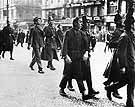
|
|
|

|

|

|

|
|
Click on an image to see a larger, more detailed picture.
|
|
|
|
|
| PROLOGUE: Roots of the Holocaust |

|
pg. 24 |

|
|
|
|
| |
 Frustrated by long-term unemployment, German workers rioted in Berlin in October 1923. Police quelled the riot and marched the demonstrators to prison.
Frustrated by long-term unemployment, German workers rioted in Berlin in October 1923. Police quelled the riot and marched the demonstrators to prison.
Photo: AP/Wide World Photos
|
 Gustav von Kahr, the nationalistic state commissioner of Bavaria, squelched Hitler's grab for power in Munich in 1923.
Gustav von Kahr, the nationalistic state commissioner of Bavaria, squelched Hitler's grab for power in Munich in 1923.
Photo: Ullstein Bilderdienst
|
|
Once Kahr was free of intimidation, he renounced his coerced support. He also directed Bavarian police forces to be ready by midday on November 9. That afternoon Hitler and other Nazi leaders--including General Erich Ludendorff, a German war hero, and Hermann Göring, an ace fighter pilot who would become a key figure in the Third Reich--advanced toward the Odeonplatz in Munich's center with some 2000 of their followers. Blocking the Nazis' path, the state police opened fire. Sixteen Nazis and four members of the police were killed. Hitler and Göring were injured. The coup failed, but far from forgetting it, the Nazis made this early revolutionary upsurge a key part of their party's identity. The fallen Nazis became martyrs. Those who survived became specially honored heroes among the Alte Kämpfer (old fighters), the Nazis who belonged to the Party before Hitler's rise to governmental power on January 30, 1933. Meanwhile, Hitler was arrested two days after the failed coup. He stood trial for treason three months later. The court, however, was not overly concerned about Hitler's attempt to overthrow the government. Sentenced to five years in Landsberg Prison, Hitler was released after nine months, in December 1924. He had put his comfortable prison term to good use by starting to write one of the 20th century's most influential books, Mein Kampf (My Struggle), which was published in 1925. By 1933 Mein Kampf had sold more than one million copies. The 500th printing took place in 1939, and by 1945 sales had reached ten million copies. The royalties made Hitler a wealthy man. By 1933 Fritz Gerlich was a marked man as far as Hitler and the Nazis were concerned. For a decade, he had neither forgotten nor forgiven Hitler's broken promises. Gerlich never lost the conviction that had been driven home to him in 1923: namely, that deception, treachery, and ruthless violence were at the heart of Hitler's character. Gerlich determined that he would use his expertise and influence as a journalist to do his best to expose Hitler in any way he could.
|
|

|

|

|

|
 1348-1349: As the Black Death (bubonic plague) sweeps across Europe, killing indiscriminately, Jews are cast as scapegoats by people desperate to find an explanation for the terrible scourge. In Frankfurt and Worms, Germany, and at many other sites, Jews are murdered and their communities destroyed.
1348-1349: As the Black Death (bubonic plague) sweeps across Europe, killing indiscriminately, Jews are cast as scapegoats by people desperate to find an explanation for the terrible scourge. In Frankfurt and Worms, Germany, and at many other sites, Jews are murdered and their communities destroyed.
|
 15th century: Gypsies establish themselves in Western Europe.
15th century: Gypsies establish themselves in Western Europe.
|
 1490: The Spanish Inquisition charges both Jews and conversos (converted Jews) of plotting against Christians. Each group is accused of desecrating the Host. Between 1480 and 1520, perhaps 2000 to 4000 Marranos (converted Jews) are condemned to death as heretics or crypto-Jews.
1490: The Spanish Inquisition charges both Jews and conversos (converted Jews) of plotting against Christians. Each group is accused of desecrating the Host. Between 1480 and 1520, perhaps 2000 to 4000 Marranos (converted Jews) are condemned to death as heretics or crypto-Jews.
|
 1492: Jews are expelled from Spain.
1492: Jews are expelled from Spain.
|
 1516: The closed Jewish Quarter in Venice, Italy, is dubbed the Geto Nuovo (New Foundry). "Geto" will later become the basis for the word "ghetto."
1516: The closed Jewish Quarter in Venice, Italy, is dubbed the Geto Nuovo (New Foundry). "Geto" will later become the basis for the word "ghetto."
|
|
|
|
|
| PROLOGUE: Roots of the Holocaust |

|
pg. 24 |

|
|
The Holocaust Chronicle
© 2009 Publications International, Ltd.
|
|
